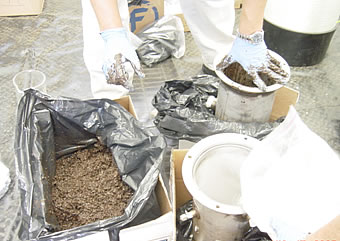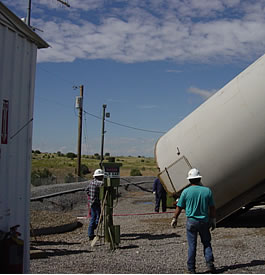This is part of a long-term effort between the University of Texas at Austin, NMT, and LANL. SMZ is a filtration/sorption medium that can be cost-effectively produced using naturally occurring zeolites and commercially available surfactant. UT-Austin has demonstrated the potential of SMZ for BTEX removal at laboratory and pilot scales. The most recent efforts have focused on issues associated with off-gas emissions during regeneration cycles by including a vapor phase bioreactor (VPB) in the off-gas treatment scheme that biologically converts the BTEX compounds to innocuous by-products. Other recent efforts have included the removal of organic acids using a biologically-based removal system. This research builds on previous work indicating that SMZ is well-suited for the treatment of produced water. Previous studies demonstrated the use of SMZ to sorb organic compounds from produced water in the laboratory and in a field-scale study.
Results
This project is a subcontract to the main project, DE-PS26-04NT15546, with the University of Texas. Patent application for the treatment process is in progress through LANL’s legal team. Additional testing of an add-on unit for removal of organic acids was performed in the lab at UT-Austin and field tested in August at the McGrath reinjection facility in Farmington. Final results have been documented in the Ph.D dissertation by Soondong Kwon, a student at UT-Austin. A publication on long-term regeneration performance was written by Craig Altare (Master’s student) and Dr. Robert Bowman at NMT and published by Microporous and Mesoporous Materials journal. Collaboration with Texas A&M has been established, to take advantage of its desalination process facility in College Station, TX as well as field test capabilities which were used in the final field test. LANL evaluated possible interactions of the SMZ columns with reverse osmosis (RO) membranes in March 2007 at TAMU and found no significant interactions. This was verified by the field study in August 2007. Successful removal of organic acids and nonpolar organic constituents from produced water was documented in this field study. Some problems including scaling and foaming were also documented. Additional outside funding has been secured from the New Mexico Technology Research Center for assistance in developing the process to the level of commercialization. This will include building a field test unit in addition to an RO system. This additional funding was awarded to NMT and LANL.
In 2005, the project installed and ran a pilot test of the SMZ-VPB system at a field facility in Farmington, NM. This water is the anticipated source water to be treated for the San Juan Generating Station run by Public Service Co. of New Mexico.
Previously, in FY 2006, an engineering model included design criteria and assumptions, including sizing and specifications for SMZ tanks. Cost analysis indicates that the SMZ/VPB process is a cost-effective means of removal of organics, particularly when capital costs are amortized over a reasonable time frame. Costs were also calculated to include an additional RO system (not field-tested). An engineering cost study was performed to compare costs of current oil and gas water disposal practices versus the cost of treatment with the SMZ-VPB system along with reverse osmosis (installed and annualized costs). Treatment and disposal of co-produced water have a direct impact on the profitability of O&G production. The disposal cost for a barrel (40 gal) of water is between $1.76 and $4.91 (2006 prices). Treatment using the SMZ/VPB system with RO has a lower cost at higher flow rate. At 6 gpm, the total per barrel cost varies from $0.16 to $0.19, and at 40 gpm, from $0.13 to $0.14. Even when the cost of disposing of residual reject water from the RO system is included, this is competitive. The best economies of scale can be found at higher flow rates.
Benefits
The increasing need for broader areas of beneficial reuse of produced water and other lower-quality waters has become apparent, given water supply and cost issues. As water becomes scarce in many regions of the country, particularly the arid western states, the valuation of water resources is expected to increase. Beneficial reuse of water normally not considered to be usable, such as produced water, is expected to increase proportionately. The results of this laboratory- and pilot-scale program suggest that the SMZ/VPB system may contribute significantly, in a cost-effective manner, to this trend.
Summary
Researchers have:
- Completed work on engineering analysis and cost analysis for the long-term test based on pilot results.
- Evaluated engineering design data for use in long-term project system design.
- Completed two short-term pilot tests.
- Applied for patent protection of the system.
- Secured funding for commercialization development.
- Evaluated interactions between SMZ columns, organic acid removal system, and RO system membranes
- Measured successful removal of polar and nonpolar organic constituents from produced water under a variety of field conditions and initial water quality conditions.
A prototype Surfactant-Modified Zeolite (SMZ)/Vapor Phase Bioreactor (VPB) treatment system was built and tested for removing dissolved organics from produced water prior to demineralization. The SMZ unit adsorbs the organic compounds from the water stream, then air stripping is applied to send the volatile organic compounds to the VPB. The VPB biologically converts the BTEX compounds to innocuous by-products at up to 99% removal efficiency. We have demonstrated this technology at the pilot scale in the field, including removal of all types of non-polar organic compounds up to 99%. Future work includes a long-term field test, linkage of the SMZ-VPB test setup with a reverse-osmosis system, addition of a separate treatment unit to handle dissolved organic acids and other polar organics (in lab testing now), and electronic automation of the system to reduce operating costs and increase efficiency.





